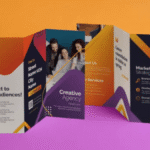In the world of marketing, professional brochure printing plays an essential role. It is a powerful tool that enables businesses and individuals to communicate effectively with their target audiences. Incorporating strategic design and clear messaging, well-crafted brochures can significantly boost a brand’s image. Let us delve deep into this topic to understand its intricacies and benefits.

The Importance of High-quality Brochures
Creating a high-quality brochure transcends simply conveying information. It’s about crafting an experience. It is crucial for marketing professionals to ensure that the information is presented in an engaging way that appeals to the intended audience. This includes comprehensive design elements and a meticulously chosen layout that captivate potential customers.
Engaging Content in Brochures
Content is a key component of any professional brochure printing project. The language used should be simple yet impactful, ensuring that the core message is communicated effectively. Remember, the primary goal is to inform and persuade, making the content a decisive factor in achieving this.
Visual Appeal and Design
The design should be visually stimulating and align with the brand’s identity. Using colors, fonts, and images wisely can lead to a significant impact. For those seeking inspiration on what is a brochure, this essential guide can offer insights into creatively blending design elements into a cohesive brochure layout.
Choosing the Right Materials
When it comes to professional brochure printing, the choice of materials matters. From the type of paper to the finish, every aspect contributes to the final product. It is crucial to select materials that not only look good but also feel good to the touch.
Different Paper Types
There is a range of paper types available, each offering distinct benefits. Glossy paper, for example, gives brochures a sleek look and enhances colors, making them pop. Learn more about the best options in our article on brochure finishes.
Various Finishes
The finish can alter the overall feel of a brochure. While glossy finishes are eye-catching, matte finishes provide an elegant, understated appearance. Understanding these differences is crucial for making an informed decision.
Choosing a Reliable Printing Service
Selecting the right printing service is as important as designing the brochure itself. A reputable service will have the tools and expertise needed to bring your vision to life. They will ensure high-quality prints that remain true to the original design.
Understanding Printing Costs
Printing costs can vary widely, so it’s vital to be aware of your budget and what you are getting for your money. For more detailed insights into costs, we recommend checking out our guide on the brochure printing costs.
Custom vs. Template Designs
Custom designs allow for more creativity, while templates offer a cost-effective alternative. Depending on your budget and needs, both options can yield stunning results. Consider which option aligns best with your brand’s goals.
Integrating Brochures into Your Marketing Strategy
Once your brochures are printed, incorporating them into a marketing strategy is the next step. These printed materials can be used in various settings from trade shows to product launches. Learn how they can complement digital marketing efforts as outlined in our feature on brochures for launches.
Distribution Methods
Effective distribution is key. Brochures can be handed out at events, mailed to potential clients, or even included in product shipments for maximum reach.
Measuring Success
Assessing the effectiveness of your brochures is important for future marketing efforts. Keep track of customer engagement, conversion rates, and feedback to refine your strategy over time.

Faq Section
What is the ideal size for a brochure?
The ideal size depends on the content and design of the brochure. Common sizes include 8.5×11 inches or 11×17 inches for tri-fold designs.
How many types of brochures are there?
There are several types, including bi-fold, tri-fold, and z-fold brochures. Your choice should align with your content needs.
Can brochures be integrated with digital marketing?
Yes, brochures can complement digital marketing strategies effectively by directing offline audience to online platforms via QR codes and website links.
This article contains affiliate links. We may earn a commission at no extra cost to you.






